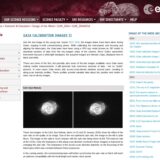Gaia calibration images II (ESA Gaia Outreach & Education, 14 Feb 2014)
Media: ESA Gaia Outreach & Education
Title: “Gaia calibration images II”
Webpage: http://www.cosmos.esa.int/web/gaia/iow_20140214
Publication date: 14 of February 2014
Like the test image of the young star cluster NGC 1818, the images below have been taken during Gaia’s ongoing in-orbit commissioning phase. While calibrating the instruments and focusing and aligning the telescopes, the Gaia team have been using a VPU spy mode (known as SIF mode) to download sections of data from the sky-mapper strips of the camera. Since Gaia’s astrometric instrument has just a white-light bandpass, the acquired images are intensity maps, displayed here in black and white.
These are some of the first, but possibly also some of the last images available: once Gaia starts making routine measurements, it will generate truly enormous amounts of data – but no “pretty” pictures. In most cases Gaia works with across-scan-binned windows around stars, resulting in along-scan intensity profiles. These profiles provide valuable data about the position and motion of stars, but no all-sky images.
Cat’s Eye Nebula
These two images of the Cat’s Eye Nebula, taken on 23 and 25 January 2014, show the effect of the spin rate on the quality of an image. Due to the non-optimized spin rate, the image on the left is quite blurry. The image on the right is much sharper with the spin rate being closer to the TDI read-out rate of the CCDs. Only the sharpness in the along-scan direction (vertical in these images) is improved by changing the spin rate. The sharpness in the across-scan direction depends on the focussing of the telescopes which was constant between these exposures.
In the coming weeks, the commissioning team will further synchronize the spin rate so that it will reach an optimum compatibility with the focal length and master-clock period.
Credits: ESA/DPAC/Airbus DS
NGC 2516
This image of NGC 2516 was taken after the first focus iteration. The spin rate is still to be synchronized and additional focusing iterations are to be completed to ensure a proper focus and sharp point spread functions.
Credits: ESA/DPAC/Airbus DS
Gaia vs. Digital Sky Survey (NGC 2516)
This is a rotated Gaia image section (left; extracted from the cluster image of NGC 2516 above), compared to a Digital Sky Survey image taken from the ground (right).
Credits: ESA/DPAC/Airbus DS/DSS
Messier 94
This is an image of the spiral galaxy Messier 94 taken by Gaia in its nominal scanning mode. Two adjacent sky mapper CCDs, separated by a few mm of dead space in the focal plane (which explains the black bar in the middle), were read out to obtain this image.
Credits: ESA/DPAC/Airbus DS
All images are also available in the Gaia Media Gallery.










